|
10. Spialia sertorius (Hoffmansegg, 1804) / Red underwing skipper / Hesperiidae – Pyrginae
NL: pimperneldikkopje, kalkgraslanddikkopje / D: Roter Würfelfalter, Roter-Dickkopffalter, Wiesenknopf-Würfelfalter / F: roussâtre, hespérie des sanguisorbes
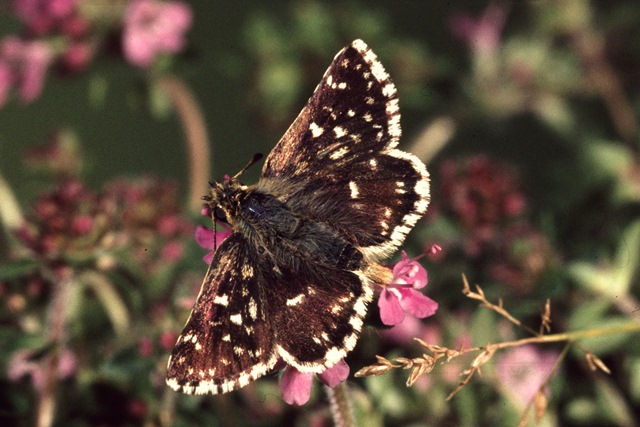 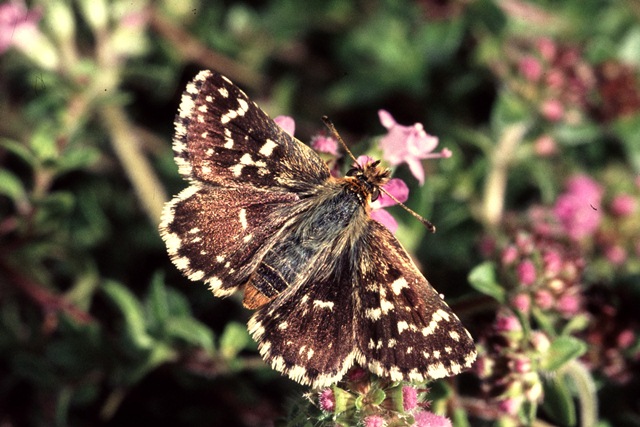 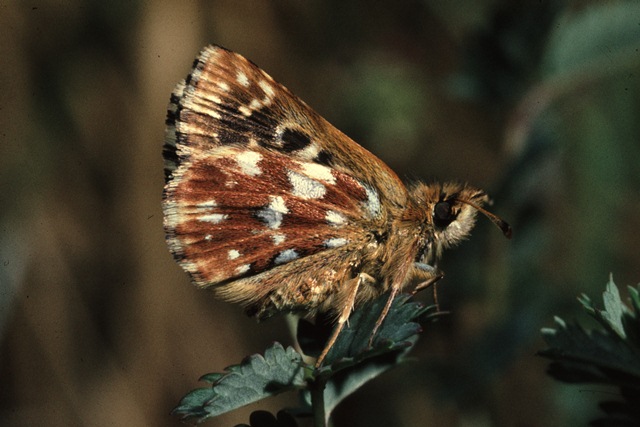
Photographs: Frits Bink ©.
Very small, wing length 11 (9-12) mm. In the Benelux this species is known only from unimproved grassland on dry and warm chalk soil, often grazed by sheep. It has disappeared from the Netherlands but in Wallonia it is still present in many sites in the valley and surroundings of the river Meuse.
Adult is on the wing from early-May until mid-June and peaks end-May. Sometimes some butterflies have been observed in August, which are considered to be a second brood. The species occurs in south-west Europe in mild continental climate, amplitude 7 to 11, and the required heat sum is 900°d and the maximum tolerated 2300°d, corresponding climate windows are 26 weeks and 41 weeks.
A second brood in late summer will be successful if there are flowers of the host plant present, the salad burnet (Sanguisorba minor), which flowers only occasionally late in the year.
The survival of a population depends not only on the availability of young flower heads, but also on the undisturbed development of the plants. Too much grazing may be deleterious to this species. A small site of only half a hectare may be suitable to support a population.
Ecological characteristics
Behaviour over time
Overwintering: full grown larva, hidden under withered leaf of the host plant.
Reproduction: oviposition starts after 5-7 days, there are then 34 (24-42) eggs in the body. Estimated potential production 2.8 as much.
Larval feeding periods: 7 weeks in early summer, from the time the host plant starts flowering. A partial second generation may sometimes occur and then the larvae are feeding until the autumn.
Generations: usually one, sometimes a partial second.
Spreading of risk: spread in the period of hatching of the adults.
Life cycle: egg about 5 days, larva 48 (40-67) days or 34-49 weeks including the overwintering, pupa about 14 days.
Life span of adult: short, 2 weeks.
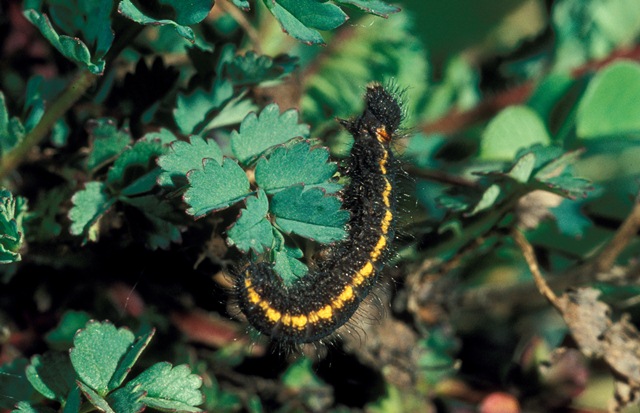 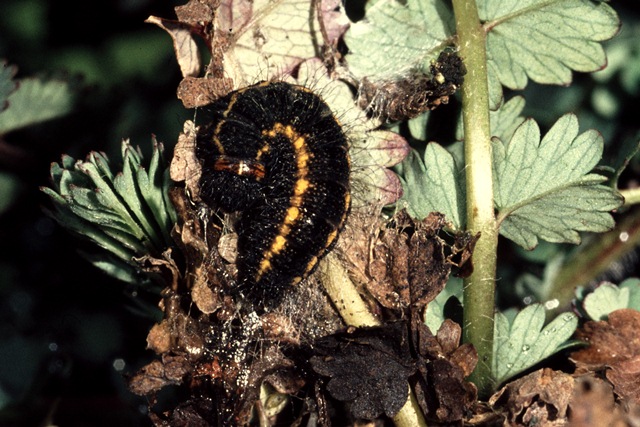
Photographs: Frits Bink ©.
Behaviour in space
From stay-at-home to migrant: stay-at-home, spatial requirement very modest.
Finding a mate: both sexes meet on flowers like thistle or knapweed.
Orientation in the landscape: grassland with short turf and places of bare soil and presence of the host plant.
Oviposition: eggs are put into the young flower heads.
Defence
Threats from other organisms: young larvae live safely inside the flower head, may be eaten by grazing sheep.
Threats from the environment: the species is known only from dry and warm sites in temperate climates, a sign that the species may be rather sensitive to unfavourable weather.
Feeding habits
Adult: nectar, mainly from flowers of thistle or great knapweed (Centaurea scabiosa).
Larva: when young it feeds on flowers and seeds, later on the sprouts in the heart of the host plant.
Larval foodplants
Plant species: Rosaceae, Sanguisorba minor.
Journal
Rearing experiments based on specimen from Nîsmes, Belgium:
1 June 1982: one female captured.
June: about 30 eggs laid in the flower heads.
5/6 June: eggs hatched, larvae lived inside the flower heads.
12 June: larvae in the flower heads ate the sepals and later on also the immature fruits. Up to 7 larvae per flower head was observed. Two larvae fed on the soft tissue of the leaves.
27 June: it was noted that there were uneven growth rates, with larvae of c. 8 mm and12 mm living together in the heart of the plant. A few lived in folded leaves of the plant.
3 July: half of the larvae in last instar.
1 August: an empty pupa case found and a few empty larval cocoons.
6 August: an adult appeared.
Overwintered outdoors
24 April 1983: a full grown larva observed under a leaf in a loose cocoon.
27 April: larva constructed a new tent.
5 June: adult appeared, female.
Table 10-1. Results of dissections

Table 10-2. Collection and observation localities
B, Nîsmes, Tiènne-Breumont 215 m, 50° 04’ 40”N – 4° 32’ 35”E; 28 May 1982, 1 June 1982.
B, Theux 50° 33’ 20”N – 5° 49’ 50”E; 17 June 1983.
D, Staffelstein 50° 05’ 32”N – 11° 01’ 25”E; 16 June 1985.
F, Aurel, 400 m, 44° 43’N – 5° 16’E; 29 August 1984.
F, Bollenberg 363 m, 47 56’ 53”N – 7 15’ 12”E; 12 June 1984.
F, Cap Blanc Nez 50° 55’ 37”N – 1° 42’45”E; 10 June2000.
F, Montmédy 217 m, 49° 31’ 07”N – 5° 21’ 33” E; 12 June 1984.
F, Vosges, Bollenberg 363 m, 47° 56’ 54”N – 7° 15’21”E; 25 July 1983, 11 June 1984.
Fig. 10-1. Spialia sertorius, phenogram adapted from Fichefet et al. 2008: 55.
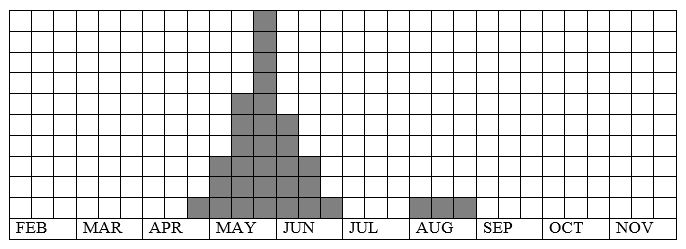
Fig. 10-2. Spialia sertorius, habitat characteristics.
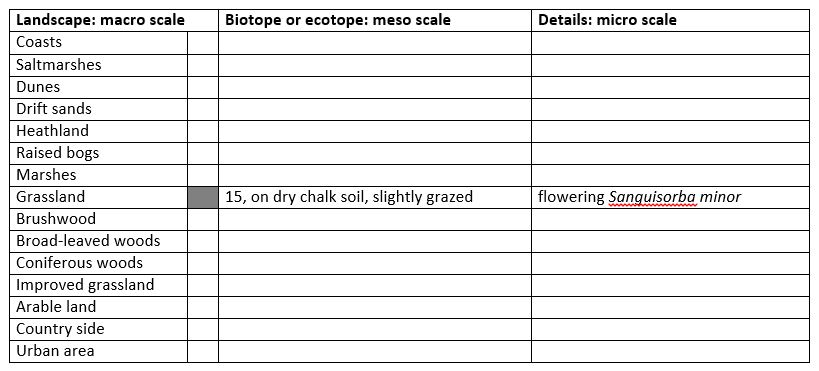
Fig. 10-3. Spialia sertorius, climate matrix, heat-sums 900 - 2300°d.
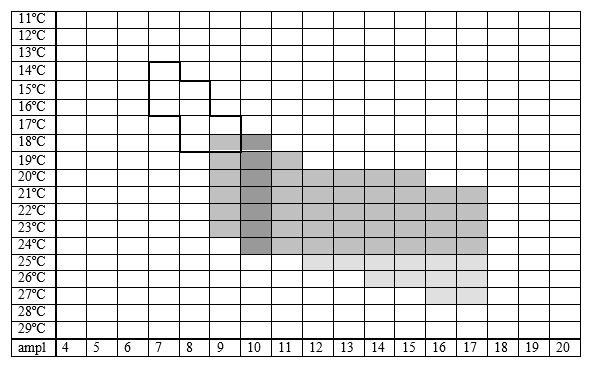
|










